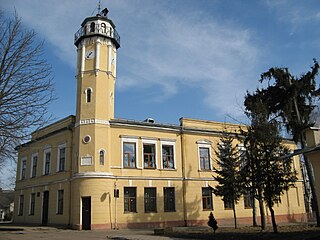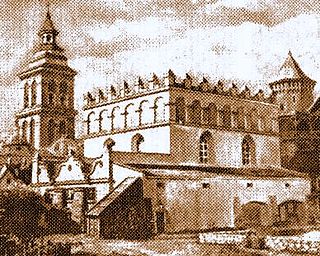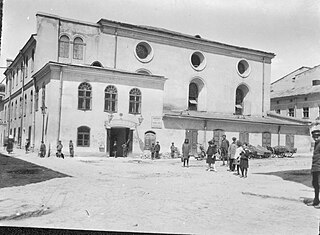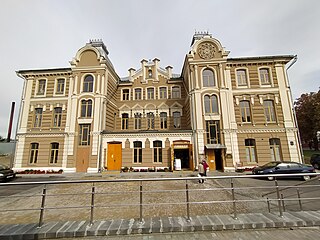
Shtetl or shtetel is a Yiddish term for small towns with predominantly Ashkenazi Jewish populations which existed in Eastern Europe before the Holocaust. The term is used in the context of former East European Jewish societies as mandated islands within the surrounding non-Jewish populace, and thus bears certain connotations of discrimination. Shtetls were mainly found in the areas that constituted the 19th-century Pale of Settlement in the Russian Empire, as well as in Congress Poland, Austrian Galicia, the Kingdom of Romania and the Kingdom of Hungary.

In July 1941, 25 Polish academics from the city of Lwów along with the 25 of their family members were killed by Nazi German occupation forces. By targeting prominent citizens and intellectuals for elimination, the Nazis hoped to prevent anti-Nazi activity and to weaken the resolve of the Polish resistance movement. According to an eyewitness the executions were carried out by an Einsatzgruppe unit under the command of Karl Eberhard Schöngarth with the participation of Ukrainian translators in German uniforms.

Brody is a city in Zolochiv Raion, Lviv Oblast, western Ukraine. It is located in the valley of the upper Styr River, approximately 90 kilometres northeast of the oblast capital, Lviv. Brody hosts the administration of Brody urban hromada, one of the hromadas of Ukraine. Population: 23,134.

Berdychiv is a historic city in Zhytomyr Oblast, northern Ukraine. It serves as the administrative center of Berdychiv Raion within the oblast. It is 44 km (27 mi) south of the administrative center of the oblast, Zhytomyr. Its population is approximately 73,046.

Galician Jews or Galitzianers are members of the subgroup of Ashkenazi Jews originating and developed in the Kingdom of Galicia and Lodomeria and Bukovina from contemporary western Ukraine and from south-eastern Poland. Galicia proper, which was inhabited by Ruthenians, Poles and Jews, became a royal province within Austria-Hungary after the Partitions of Poland in the late 18th century. Galician Jews primarily spoke Yiddish.

Yavoriv is a city in Lviv Oblast, western Ukraine. It is situated about 15 kilometres (9.3 mi) from the Polish border. It serves as the administrative centre of Yavoriv Raion and is situated approximately 50 kilometres west of the oblast capital, Lviv. Yavoriv hosts the administration of Yavoriv urban hromada, one of the hromadas of Ukraine. Its population is approximately 12,785.

Peremyshliany is a small city in Lviv Raion, Lviv Oblast (region) of Ukraine. It hosts the administration of Peremyshliany urban hromada, one of the hromadas of Ukraine. Population: 6,415.

Meir Balaban or Majer Samuel Bałaban was a historian of Polish and Galician Jews, and the founder of Polish Jewish historiography.

The Tsori Gilod Synagogue, known in more recent times as Beis Aharon V'Yisrael Synagogue, is an Orthodox Jewish synagogue, located at 4 Brativ Mikhnovskykh Street, in Lviv, in the Lviv Oblast of Ukraine.

The Jakob Glanzer Shul, also called the Chasidim Synagogue, is a former Orthodox Hasidic Jewish synagogue, located at Vuhil'na (Coal) Street Nr.3 in Lviv, Ukraine. The building operated as a synagogue from 1844 until 1962; had various uses during World War II and Soviet occupation; before being preserved as a Jewish history museum and cultural center since 1995.

The Golden Rose Synagogue, known also as the Nachmanowicz Synagogue, or the Turei Zahav Synagogue was an Orthodox Jewish synagogue, located in Lviv, in what is now the Lviv Oblast in western Ukraine. The Golden Rose Synagogue, established in 1582 in the Polish–Lithuanian Commonwealth, was the oldest synagogue in what is now Ukraine. From September 1603 until 1801, the Golden Rose served as the main communal synagogue while the Great City Synagogue expanded its facilities. Both the Golden Rose and Great City synagogues were destroyed by Nazis during World War II.

The Great Suburb Synagogue was a synagogue at Bożnicza-Street 16 in Lviv, in the Lviv Oblast of Ukraine. The synagogue was developed in stages, with the men's prayer hall completed in 1632, located in what was then the Polish–Lithuanian Commonwealth. The synagogue was destroyed by Nazi Germany in 1941 and the ruins dismantled during the late 1940s.

The Great Synagogue of Grodno, also known as the New Synagogue or the Choral Synagogue, is an Orthodox Hasidic Jewish synagogue, located on Vialikaja Trajeckaja Street, in Grodno, Belarus. The building dates from the 16th century and was nominated for UNESCO World Heritage listing in 2007.
The history of the Jews in Łęczna, Poland is first recorded and dated to 1501. The Jewish community of the town was evident and stable until the holocaust, after which it ceased to exist. The Glincman family from Wlodawa sent some family members to live there in the late 1800s to widen their business to surrounding towns. Nowadays monuments and buildings are still visible and commemorated in town.

The Great City Synagogue was a former Orthodox Jewish synagogue in the city of Lviv, in what is now the Lviv Oblast of Ukraine. It was situated in the former Jewish Quarter near today's city centre.

Staryi Rynok Square is a square in Lviv, Ukraine. It is located north of the Market Square, along Bohdan Khmelnytsky street, in the vicinity of St. Nicholas Church. The area in which the square is situated constituted the town center during the earliest period of Lviv's history, when it was part of the Galician-Volhynian state.
CENTOS was a Polish-Jewish children's-aid society. Founded in 1924, it became a "leading organization for Jewish childcare" in the Second Polish Republic and was highly active in the Warsaw Ghetto during The Holocaust in Poland.

The Great Synagogue was a former Orthodox Jewish congregation and synagogue, that was located in Oświęcim, in the Lesser Poland Voivodeship of Poland. Designed by Carl Korn and completed in 1873, the synagogue served as a house of prayer until World War II when it was destroyed by Nazis in November 1939.

The Great Synagogue is a Jewish synagogue, located on Vulytsya Zaporizʹka, in Zhovkva (Zółkiew), in the Lviv Raion of Lviv Oblast, of Ukraine. It was built between 1692 and 1698 with a financial loan from King John III Sobieski, and was hence also known as the Sobieski Shul.
























